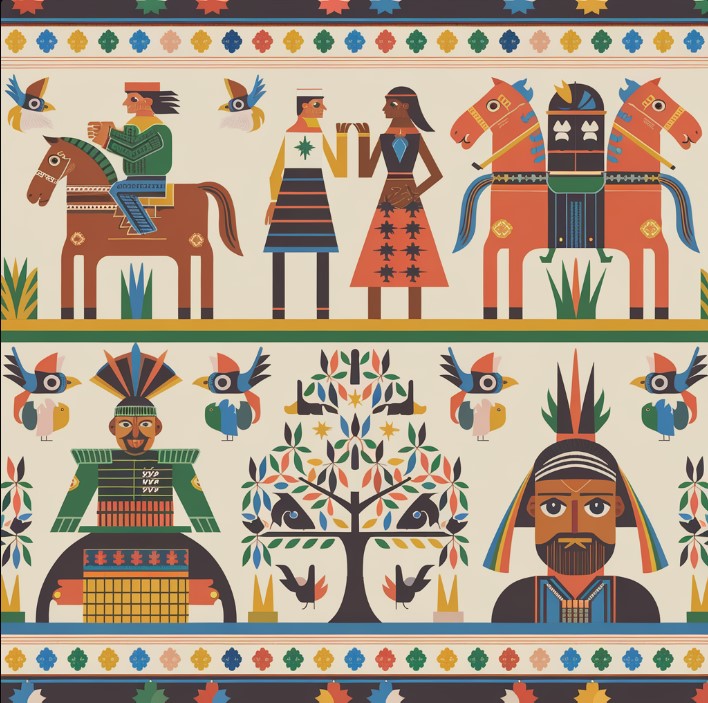Beyond Aesthetics: The Symbolic Stories Woven into Habaspuri Patterns
Habaspuri patterns, rich in cultural and spiritual significance, are an ancient form of art that reflects the deep traditions of the Habaspuri people. These intricate designs, often found in textiles, pottery, and architecture, carry symbolism rooted in nature, spirituality, and everyday life. Each pattern tells a story, conveying messages of protection, fertility, and harmony with the environment. As a visual language, these patterns transcend generations, preserving the community’s beliefs, values, and history. In exploring the symbolism behind Habaspuri patterns, we uncover their aesthetic beauty and their profound connection to identity and heritage.
Decoding the Motifs
- Geometric Shapes: Geometric patterns, such as circles, squares, and triangles, symbolize balance and harmony. They represent the universe’s order and the interconnectedness of all life.
- Floral and Nature-Inspired Designs: Floral motifs embody beauty and renewal like lotus flowers and vines. They often signify growth, fertility, and the cycle of life, reflecting a deep connection to nature.
- Abstract and Spiritual Symbols: Symbols such as the eye or spiral convey spiritual meanings, representing protection, knowledge, and the journey of life. These motifs are often seen as amulets against negative forces.
- Animal Imagery: Animal depictions, such as birds and elephants, symbolize strength, freedom, and wisdom. They remind us of wildlife’s spiritual presence in the surrounding environment.
- Cultural Heritage Symbols: Patterns may incorporate elements that reflect historical events or cultural stories, connecting the artwork to the community’s identity and shared history.
Everyday Symbols
- Spiritual and Religious Significance: Habaspuri patterns often hold spiritual meanings, with specific motifs believed to offer protection from evil spirits and bring blessings. For example, the “eye” symbol is widely used to guard against the “evil eye” and ensure harmony in the home. These designs are also seen in sacred spaces, reflecting the connection between art and spirituality.
- Life Stages and Transitions: Specific patterns are linked to important life events. Birth, marriage, and death are often marked by the use of certain motifs that signify blessings, fertility, and transition. For instance, a particular floral pattern may be used in wedding attire to ensure a prosperous future, while other symbols are used during mourning to honor the deceased.
- Connection to the Natural World: Many Habaspuri patterns are inspired by elements of nature, such as plants, animals, and celestial bodies, symbolizing the harmonious relationship between humans and the environment. These motifs reflect the cyclical nature of life and the dependency on natural resources, serving as a reminder to live in balance with the earth.
Woven in Color
- Red: Symbolizes strength, vitality, and life force. Often used in motifs representing protection and fertility.
- Black: Represents the earth, wisdom, and ancestral ties. It is frequently used to ground patterns and signify stability.
- White: Denotes purity, peace, and spiritual enlightenment. It is often seen in patterns related to the divine or sacred.
- Yellow/Gold: Associated with wealth, prosperity, and the sun. It reflects light, energy, and abundance in the community.
- Green: Represents nature, growth, and harmony. It connects the people with the earth and its cycles.
- Blue: Symbolizes water, tranquility, and life-giving forces, often reflecting the flow of energy and peace.
Modern Revival
- Adaptations and Modern Interpretations: Contemporary artists incorporate Habaspuri patterns into fashion, interior design, and digital art, blending traditional aesthetics with modern styles.
- Preservation Efforts: Various organizations and artisans are dedicated to preserving the art of Habaspuri by conducting workshops and exhibitions, ensuring that these patterns remain relevant.
- Cultural Identity: Habaspuri patterns symbolize cultural identity and pride in a globalized world, helping younger generations maintain a connection to their heritage.
- Artistic Collaborations: Cross-disciplinary collaborations between traditional artisans and modern designers foster innovation while respecting the roots of Habaspuri art.
- Tourism and Economic Impact: The popularity of Habaspuri patterns attracts tourists, boosting local economies through art sales and cultural experiences.
Final Thoughts
Habaspuri patterns are not merely decorative but serve as a profound cultural language, bridging the past with the present. Each motif carries deep symbolism, representing spirituality, nature, and community values. These patterns reflect the rich heritage of the Habaspuri people and their connection to the world around them. As modern adaptations emerge, the continued relevance of these designs highlights their enduring power to unite generations, preserve cultural identity, and inspire global recognition. Through their beauty and meaning, Habaspuri patterns remain a vital link to tradition, offering both protection and pride for the future.


